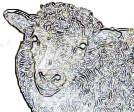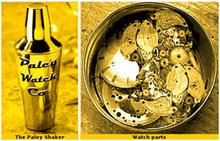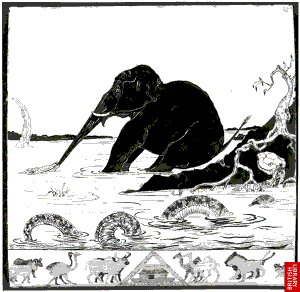 According to Ivan R Schwab of the University of California, to equip the bird for its ecological niche, evolution has provided the woodpecker with a thick bony skull with relatively spongy bone, especially at the occiput, and cartilage at the base of the mandible to partially cushion the incessant blows. This woodpecker has evolved several unique mechanisms to prevent brain damage, retinal haemorrhages, and retinal detachment. The woodpecker has other unique adaptations that deserve recognition and may contribute to the protection from intracranial injuries. The tongue is most unusual as it originates on the dorsum of the maxilla, passes through the right nostril, between the eyes, divides into two, arches over the superior portion of the skull and around the occiput passing on either side of the neck, coming forward through the lower mandible, and uniting into a single tongue in the oropharyngeal cavity. The muscles encase the bony hyoid throughout this muscular course into the oropharynx and are additionally secured in the floor of the mouth creating an apparatus that allows for extraordinary protrusion of the tongue of up to 4 inches beyond the tip of the bill! These musculotendinous bands create a curious sling-like structure that probably functions as an isometric shock absorber if contracted before each strike. This sling would also serve to distribute the potential shearing forces. Such length is useful for penetrating insect nests beneath the bark of trees. The sharp tongue (literally) is coated with sticky saliva for smaller insects such as ants and has backward pointing barbs that are useful in impaling larger insects and grubs. For added emphasis, the tongue is equipped with excellent tactile abilities to allow for recognition of smaller insects, such as ants. The chisel tipped mandibles are constructed of individual fused plates of keratin called rhamphotheca, and the longitudinal trabeculae are reinforced with calcium.
According to Ivan R Schwab of the University of California, to equip the bird for its ecological niche, evolution has provided the woodpecker with a thick bony skull with relatively spongy bone, especially at the occiput, and cartilage at the base of the mandible to partially cushion the incessant blows. This woodpecker has evolved several unique mechanisms to prevent brain damage, retinal haemorrhages, and retinal detachment. The woodpecker has other unique adaptations that deserve recognition and may contribute to the protection from intracranial injuries. The tongue is most unusual as it originates on the dorsum of the maxilla, passes through the right nostril, between the eyes, divides into two, arches over the superior portion of the skull and around the occiput passing on either side of the neck, coming forward through the lower mandible, and uniting into a single tongue in the oropharyngeal cavity. The muscles encase the bony hyoid throughout this muscular course into the oropharynx and are additionally secured in the floor of the mouth creating an apparatus that allows for extraordinary protrusion of the tongue of up to 4 inches beyond the tip of the bill! These musculotendinous bands create a curious sling-like structure that probably functions as an isometric shock absorber if contracted before each strike. This sling would also serve to distribute the potential shearing forces. Such length is useful for penetrating insect nests beneath the bark of trees. The sharp tongue (literally) is coated with sticky saliva for smaller insects such as ants and has backward pointing barbs that are useful in impaling larger insects and grubs. For added emphasis, the tongue is equipped with excellent tactile abilities to allow for recognition of smaller insects, such as ants. The chisel tipped mandibles are constructed of individual fused plates of keratin called rhamphotheca, and the longitudinal trabeculae are reinforced with calcium.Storyteller : Ivan R Schwab University of California, Davis, Department of Ophthalmology







.jpg)























No comments:
Post a Comment